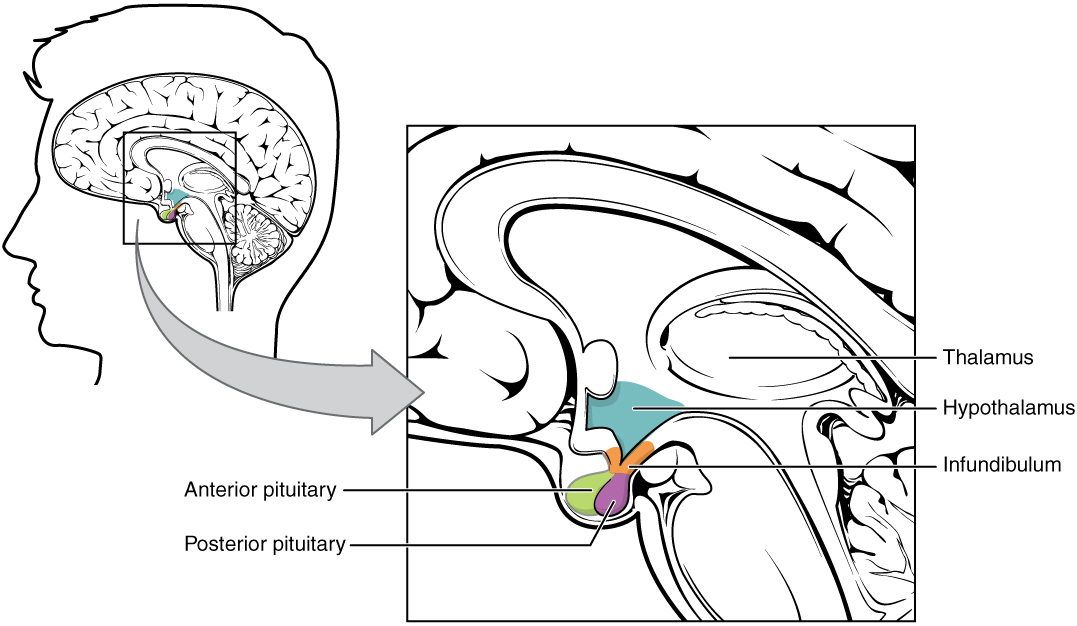Playlist
Show Playlist
Hide Playlist
Pituitary Gland: Target Organs
-
Slides 04 Human Organ Systems Meyer.pdf
-
Reference List Histology.pdf
-
Download Lecture Overview
00:01 So, we can now summarize the structure of the pituitary gland, and then we can start to assign different secretory products from those different components of the pituitary gland. Firstly, I did mention earlier, that the posterior pituitary, the neurons in the supraoptic and paraventricular nuclei synthesize ADH and oxytocin. And they’re released in the posterior pituitary into those fenestrated capillaries I’ve just mentioned. And those two hormones have effects on various target organs that I’ve listed there, and just basically, they’re general function of those hormones, what they actually bring about in those organs. And this is just the summary. 00:54 Endocrinologists will deal with the sorts of roles these hormones have in far more detail. Here, I’m only giving the histological background and basis for these hormonal products. If we then look at the acidophils in the anterior pituitary, then we can see that there are, first of all, hormones we group together as being lactotrophs, secreting prolactin. Or there could be somatotrophs involved with growth hormone secretion who act via a liver and via somatomedins. And you can see there the target organs for each of these hormones. The lactotrophs and the somatotrophs, or at least the somatotrophs, occupy about 50% of all the cells in the anterior pituitary. The lactotrophs, those that secrete prolactin, occupy between 15% and 20% of the cells in the anterior pituitary. 02:10 The basophils by far are the busiest group of epithelial secretory cells in the anterior pituitary. 02:20 And again, I’ve listed the general functions of the different hormones secreted by these basophils, the corticotrophs that affect the adrenal cortex. They too occupy about 15% to 20% of all the secretory cells in the anterior pituitary. The thyrotrophs occupy just a small percentage, perhaps 5%. 02:47 And the gonadotrophs occupy, again, only about 10%. So there is this variation in the numbers of various cell types in the anterior pituitary that secrete all these different hormonal products, thyroid stimulating hormone, follicular stimulating hormone, luteinizing hormone, and adrenocorticotropic hormone. And I’ll refer to these hormones in more detail when I actually cover all these different organs in other lectures. 03:25 I’d like to now just point out the variation in this particular slide of all the organs affected by the pituitary, by hormones secreted by the pituitary. And I want you to recall what I’ve said earlier that endocrine cells secrete hormonal products that are carried via the blood stream to target organs at locations a long distance away. When you look at this diagram and you look at the various organs represented, it makes that point very, very clear and very, very obvious. 04:03 In summary then, it’s important that you understand the structure of the pituitary gland, particularly, the two components of the pituitary gland. It’s important you understand the different types of secretory components within both the posterior and the anterior pituitary, and the secretory cells within them and what the secretory products are from each of those cells, and the general target organ and general function of those different hormones. It’s also very, very important to understand that hypothalamo-hypophyseal portal system and then how that allows the communication between releasing factors from the hypothalamus, and also factors from other parts of the central nervous system, how those releasing factors can either stimulate or inhibit cells in the anterior pituitary and even control their function. So thank you for listening to this lecture. I hope you now have a very good understanding of the pituitary gland and the general features of hormones and the endocrine glands.
About the Lecture
The lecture Pituitary Gland: Target Organs by Geoffrey Meyer, PhD is from the course Endocrine Histology.
Included Quiz Questions
Somatomedins promote cell growth in response to stimulation by which of the following hormones?
- Growth hormone
- Thyroid hormone
- Cortisol
- Insulin
- Prolactin
Which of the following cells are most abundant in the anterior pituitary gland?
- Somatotrophs
- Thyrotrophs
- Lactotrophs
- Corticotrophs
- Gonadotrophs
Somatomedins are produced by which of the following organs?
- Liver
- Adrenal cortex
- Kidney
- Stomach
- Thyroid
Customer reviews
5,0 of 5 stars
| 5 Stars |
|
1 |
| 4 Stars |
|
0 |
| 3 Stars |
|
0 |
| 2 Stars |
|
0 |
| 1 Star |
|
0 |
Thank you for the lecture! Finally this topic is clear to me




